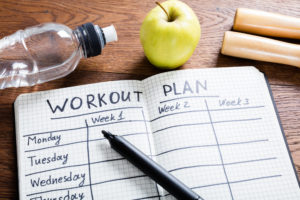We all get into a rut sometimes when training. It is easy to lose purpose, log junk miles on the road, or even get lazy in the gym. This haphazard way of training rarely leads to the results that we are looking for and often ends with an injury. All this month we are dedicating our health newsletters to improving your training with tips on how to train better and ways to prevent overuse injuries. Our goal at [Core] is to help you become healthier than you have ever been with chiropractic care, nutrition, and exercise. Let us be a part of your health team and together we can accomplish great things.
1. Avoid pre-workout static stretching
Static stretching reduces neural drive, particularly of the most powerful type 2 fibers. The negative effect on performance is large: In one study, trained cyclists had a very significant 26% reduction in time to exhaustion with marked lower exercise efficiency after static stretching. This means that stretching not only leads to reduced maximum strength, but also degrades endurance performance. This is key for anyone training in the gym, trying to power up a hill on the bike, or while running.
Similar studies have shown that runners who statically stretch the hamstrings prior to their run reduce their efficiency dramatically. Not only did this result in a slower run but it also increased their overload and potential injury to their knees and hips.
Tip #1: Instead of static stretching, do a dynamic warm-up that primes the muscles and jazzes up the nervous system prior to training. This will elicit peak performance and reduce the likelihood of injury. You can raise body temperature and heart rate with low to moderate activity. Walking, high knees, butt kicks, overhead squats, and kettlebell swings are great dynamic workouts. Please do not count bending over to tie your shoes as your entire dynamic warm up.
2. Pick a priority and train for it
Everybody wants it all from their training. Fat loss, strength, speed, and endurance are all commendable goals but they require different types of training. Trying to incorporate everything into your workout dilutes your training to the point of making it unproductive. The solution is to pick a priority and train for it. For example, if you’re training for fat loss prior to your Spring Break trip, your first priority is to lose the fat around your midsection. Do not focus on sit-ups or isolation lifts for your midsection, instead train with multi-joint exercises that tax the whole body. When done with short rest periods and moderately heavy weights you will accomplish the fat loss goal that you desire.
 Tip #2: A written plan helps with the prioritization process. Sitting down with your calendar and seeing the big picture is a great place to start. Then, break up your workouts into several week-long blocks with particular training goals in mind. Finalize your plan with specific workouts on a weekly or daily basis. This helps to prevent showing up to train without a plan of what you are going to accomplish each day.
Tip #2: A written plan helps with the prioritization process. Sitting down with your calendar and seeing the big picture is a great place to start. Then, break up your workouts into several week-long blocks with particular training goals in mind. Finalize your plan with specific workouts on a weekly or daily basis. This helps to prevent showing up to train without a plan of what you are going to accomplish each day.
3. Record your training activities
It is one thing to have a plan but it is another to continue following it. When you enter into your workout you want to keep focus and drive. Recording your workouts on a piece of paper, Strava, Zwift, or other workout app help to keep a superior degree of effort and determination with each training session. This will translate to faster progressions and help to serve as a warning light for possible overuse injuries. Don’t forget to record your rest days as well. These days are equally as important to reduce cortisol that results from the breakdown of muscle tissue during long training sessions.
Tip #3: Ask several of your training friends how they record their workouts. Various people have different ways of doing this. Find which one works for you and start using it today. The more data you collect, the more productive your daily training will be. This data is also very helpful for a coach or healthcare provider if you run into trouble with your workout programming.
4. Don’t forget to cool down
Cool downs are where you can get your stretching in, if you like. I would still avoid stretching the hamstrings, low back, or upper shoulders but other muscles can be stretched gently. A foam roller is a great tool to use as well. A few minutes of yoga, walking, or tai chi will allow your nervous system to settle for a faster recovery. Targeting tight muscles with simple movements or light static stretching can help to maintain range of motion around the joint for better mobility and more effective training the next day.
Tip #4: Foam rolling immediately after a workout is recommended. However, if you trained earlier in the day, foam roll again before you go to bed. Use the foam roller with the idea of moving lactic acid and other waste metabolites out of the tissues. I would not suggest trying to break up tight or knotted muscles as this will bruise and further damage them.
5. Eat with your training in mind
During a building phase of training try eating more protein than normal. Eating extra protein supplies both your body with the amino acid building blocks necessary to repair and build muscle tissue. Studies consistently show that when hard training is performed, extra protein in the post-workout period increases strength gains. Likewise, the amino acid L-glutamine is helpful for muscle recovery when trying to nurse an injury or prevent one.
Tip #5: Shoot for a bare minimum of 1.6g/Kg of protein a day in 25-gram doses. This will ensure that you are getting all of the protein you need to increase muscle mass and strength. Depending upon your protein source, you may also need to supplement with L-glutamine. I recommend 10g of L-glutamine from either your protein supplement or by itself for injury prevention and recovery.
You are already spending a lot of time training, so make sure that you pay attention to these tips to maximize your efforts. Dedication to the details of your workouts, nutrition, and muscle recovery often determines whether or not you will reach your goals. Discipline, execution, and time is the recipe for success. Let us know if we can help you be successful in becoming healthier than you have ever been by emailing or calling us.

Daryl C. Rich, D.C., C.S.C.S.






